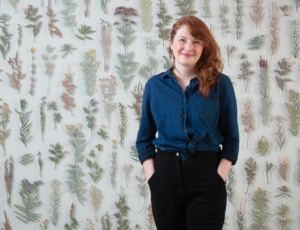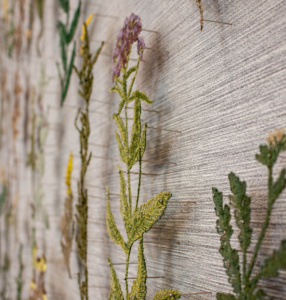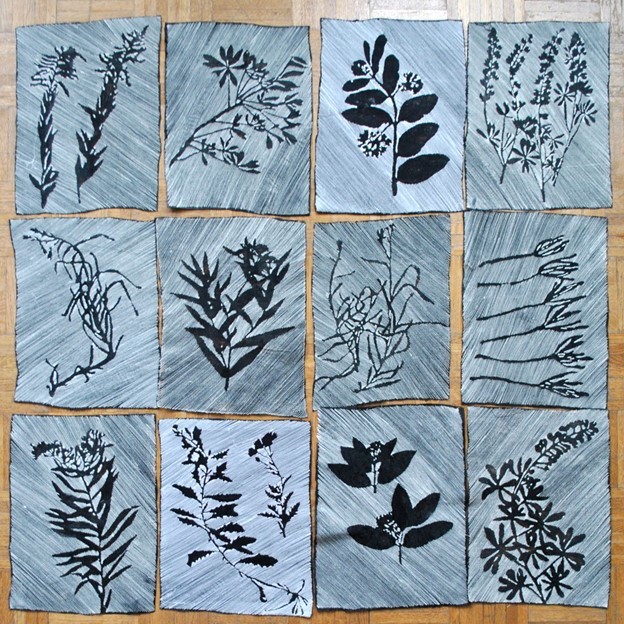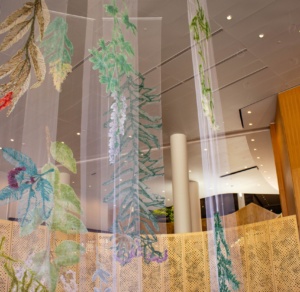Amanda McCavour’s site-specific installation draws from her original work created for the University of Wisconsin-Madison in 2019, which previously hung in the Chazen Museum of Art. Her process began with visits to the Wisconsin State Herbarium, where she studied preserved botanical collections, and the Helen Louise Allen Textile Collection. This research informed her ongoing exploration of connections between scientific documentation and decorative patterns found in textiles and wallpaper.
 McCavour’s interest in textiles stems from her background in drawing. She sees her use of thread as a type of drawing in space, creating delicate botanical forms that exist without traditional support structures. Her embroideries are made by sewing into fabric that dissolves in water. Prior to dissolving, she builds up forms through stitched lines and crossing threads. When the fabric is dissolved, the thread drawings interlock together even without a base, creating a biological network—a bound system that sustains a community of embroidered plants.
McCavour’s interest in textiles stems from her background in drawing. She sees her use of thread as a type of drawing in space, creating delicate botanical forms that exist without traditional support structures. Her embroideries are made by sewing into fabric that dissolves in water. Prior to dissolving, she builds up forms through stitched lines and crossing threads. When the fabric is dissolved, the thread drawings interlock together even without a base, creating a biological network—a bound system that sustains a community of embroidered plants.
For the CDIS building installation, McCavour has adapted her prairie plant studies, transforming them into a site-specific work that responds to the new architectural environment. The installation maintains her signature technique while creating new relationships between botanical forms and interior space.
Prairie Plant Studies is a 25-foot wide installation of embroidered pieces pinned to the wall near the Orchard Street entrance of Morgridge Hall, across from Hello World Auditorium.
Ode to a Prairie is a series of 30-foot sheer banners located near the northeast entrance off of University Avenue. The art hangs from the first floor and extends to the basement level.
 Prairie Plants: Studies
Prairie Plants: Studies
Materials: Thread, Pins
Year: 2021-2022
This wall of embroideries is based on pressed flowers indigenous to the Wisconsin Prairie that McCavour studied at the Wisconsin State Herbarium. The work demonstrates her interest in finding connections between scientific research and decorative patterns found in textiles and wallpaper. These pieces are made by sewing into fabric that dissolves in water. Prior to dissolving, she builds up stitched lines and crossing threads. When the fabric is dissolved, the thread drawings interlock together even without a base. This technique creates a powerful connection to plant ecologies, which are similarly linked—biological networks that form bound systems sustaining entire plant communities.
Ode to a Prairie
Materials: Materials: Nylon Netting, Digital Print on Polyester Chiffon, Adhesive
Year: 2021-2022
McCavour’s site-specific installation for the CDIS building reimagines interior space as a field of botanical forms, blending scientific documentation with imaginative interpretation. The work explores plants as markers of memory and place, referencing indigenous species while creating new relationships within the contemporary architectural environment.
The installation transforms small botanical specimens into monumental forms, creating environments that shift between transparency and opacity, intricate detail and large-scale impact, organic forms and constructed space. McCavour has designed this work with these oppositions in mind, emphasizing how delicate natural forms can activate and transform interior spaces.
Based on her prairie research, this work looks both to preserved botanical collections and toward contemporary possibilities for how we experience and understand plant life within built environments. The installation invites viewers to consider their relationship to indigenous plant communities while moving through spaces designed for learning and collaboration.


